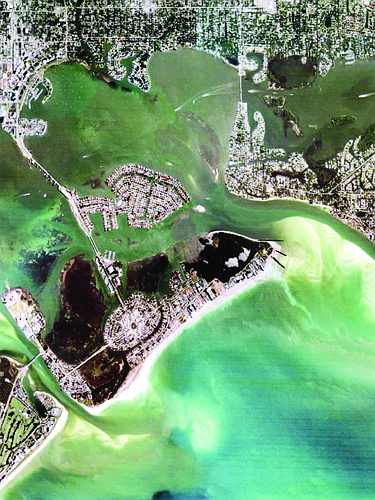- April 25, 2024
-
-
Loading

Loading

Amid a rising tide of demands for more scrutiny of a U.S. Army Corps of Engineers proposal to mine Big Pass for Lido Beach sand by 2015, a geographic oversight might ultimately leave the project’s fate in the hands of the Sarasota County Board of County Commissioners.
Discussion at a Nov. 1 West Coast Inland Navigation District meeting revealed that one of the project’s proposed erosion-control jetties, known as groins, is scheduled to be built on county property at the southern end of Lido Beach. This latest twist in the decades-long debate about dredging Big Pass will allow the county to stall a key component of the Corps’ plans by refusing permission to build on county land. According to the project manager, Milan Mora, this would likely scrap the entire operation.
Commissioner Nora Patterson said the groin’s location on county property doesn’t necessarily mean the county can stop the project, but it will increase the County Commission’s leverage to demand the project face greater scrutiny.
“I think we should hold at least one public hearing,” Patterson said. “And before we hold the public hearing we should tell the Army Corps that they should find someone to do an independent peer review.”
Patterson said she would vote against the use of county property for the contested groin if the Army Corps failed to prove the project would have no negative effects on the navigability of Big Pass or the health of Siesta Key beaches.
If the county and the Corps can’t come to a compromise about the groin planned for county land, the feasibility study used to predict the project’s impact on Siesta Key (based on the inclusion of all three groins) will have to be redone, which would send the plan “back to square one,” Mora said at a recent WCIND meeting. “And that means it will take a whole lot longer to renourish Lido.”
Echoing Patterson’s remarks, Siesta Key residents and community groups have also called for more detailed analysis and public airing of the Corps’ plan.
The Siesta Key Village Association and the Siesta Key Association have both advocated for public hearings and an independent peer review of the dredging project, although neither group has taken an official position on the Corps’ plans.
SKA board member Peter van Roekens said independent researchers have not properly vetted the project, leaving too much margin for error in predictive models and an unacceptable degree of uncertainty on the impact to Siesta Key beaches.
“One of the biggest threats we face on Siesta Key is the dredging of Big Pass,” van Roekens said.
SKA President Catherine Luckner said the groin’s location on county land will make public hearings on the dredging project more likely to happen.
“Because it’s county land, it’s really now a county issue,” Luckner said. “It changes the basis on which we have the right to ask for public input.”
SKA voted in August to commission an independent review of the Corps’ plans, but the group is waiting for the county to conduct its own review before proceeding.
The Lido Beach renourishment project will initially remove 35 million cubic yards of sand from Big Pass’s outer shoal, followed by subsequent dredges and renourishments to be conducted periodically over 50 years.
Central to the Corps’ proposal are three groins to be built along a quarter-mile stretch of south Lido Beach. The groins are intended to slow the southerly drift of sediment, increasing the interval between renourishments from three years to five years, potentially saving the county and city millions of dollars over the lifespan of the project. Lido Beach has been renourished five times since 1997, and Big Pass has never been dredged.
City estimates put a $22 million price tag on the dredge, with federal funds covering about 62% of the project. The city of Sarasota and the state will be responsible for the rest, with the city’s contribution drawing on county Tourist Development Tax revenue.
The Army Corps plans to apply for permits at the end of November, secure funding in 2014 and begin construction in 2015.
If you go
The U.S. Army Corps of Engineers will present its Big Pass dredging plans to the public at 4:30 p.m. Dec. 5, at St. Boniface Church, 5615 Midnight Pass Road, Siesta Key
Contact Nolan Peterson at [email protected]